Jonathan Greenert
-
- US Navy Build Programs Face Budget Pressure Maritime Reporter, Jun 2014 #28
Ship construction programs move ahead, but it’s not smooth sailing.
Navies and Coast Guards everywhere face budgetary pressure, even in the U.S. which has the largest Navy in the world. The balance between desire for capacity and capability and pressure for affordability has never been more acute with the precarious budgetary issues presented by declining defense budgets, sequestration, continuing resolutions and government shutdowns. Even so, there are ongoing major construction efforts to include large nuclear aircraft carriers and submarines, amphibious ships, destroyers and smaller combatants, albeit with compromises in quality, quantity and capability.
To prepare the Navy’s program within the fiscal constraints, Chief of Naval Operations Adm. Jonathan Greenert set the following six priorities. “Number one is the sea-based strategic deterrence. Number two, forward presence. Three, the capability and the capacity to win decisively. Number four, the readiness to do that. Number five, to sustain our asymmetric capabilities and our technological edge. And number six, to sustain a relevant industrial base. Using these priorities, we build a balanced portfolio of capabilities within the fiscal guidance provided. We continue to maximize our presence in the Asia-Pacific and the Middle East using innovative combinations of rotational, forward-basing, and forward stationing forces.”
U.S. naval shipbuilders are components of large defense companies. General Dynamics own Electric Boat in Groton, Connecticut, which builds SSNs; Bath Iron Works in Maine, currently building Zumwalt and Arleigh Burke class DDGs; and NASSCO in San Diego, California, where they are building the mobile landing platform (MLP). Huntington Ingalls Industries owns yards in Newport News, Virginia; Pascagoula, Mississippi; and Avondale, Louisiana, and are building aircraft carriers (CVNs), attack submarines (SSNs); guided missile destroyers (DDGs), amphibious assault ships (LHSs) and amphibious landing platforms (LPDs).
Two second-tier yards which are subsidiaries of larger foreign-owned companies are also building ships for the U.S. Navy. Italian shipbuilder Fincantieri owns Marinette Marine in Marinette, Wis., where the Freedom variant of the littoral combat ship (LCS) is being constructed; and Australia-owned Austal USA is building the Independence variant LCS platform in Mobile, Alabama, along with the joint high speed vessel (JHSV).
Submarines
The U.S. Navy announced a $17.6 billion multiyear buy of Virginia-class submarines on April 28 that will keep General Dynamics Electric Boat and Huntington Ingalls Newport News shipyards busy for a decade. EB was selected as the sole source prime contractor for the $17,645,580,644 fixed-price incentive multiyear contract, with Huntington Ingalls as the largest sub-contractor. Together, both companies have delivered 10 Virginia-class submarines to the Navy, with eight more already under contract.
The newest Virginia-class SSN, North Dakota (SSN-784), was christened Nov. 2, 2013 at Electric Boat, but her commissioning, which was scheduled for May 2014, has been rolled back until some design and material issues are resolved. It is still on track to deliver prior to its August 31 contract delivery date. North Dakota is the first Virginia-class boat with a redesigned bow which features a pair of Multiple All Up Round Canisters (MAC) for Tomahawk land attack cruise missiles.
Aircraft Carriers
The newest nuclear aircraft carrier, Gerald R. Ford (CVN 78) was christened Nov. 9, 2013 at Newport News Shipbuilding. Two others, John F. Kennedy and Enterprise, are underway in the construction pipeline.
The Navy budget says it continues to support a fleet of 11 aircraft carriers, but Sen. Carl Levin (D-MI), chairman of the Senate Committee on Armed Services, says, “The budget in Future Years Defense Program, the FYDP, includes a plan to retire rather than refuel the George Washington. To follow through on the 11 carrier fleet, the administration would have to add almost $4 billion to the FYDP to refuel and retain George Washington.”
Expeditionary Warfare Ships
The Navy has a total of nine amphibious assault ships (LHAs and LHDs). HII is building America (LHA 6), designed to transport Marine Expeditionary Units and their equipment. At 257m long with a 32m beam, it displaces 44,854 tons. It has crew of 1,204 and can transport up to 1,800 troops and their equipment. It has been built to operate the V-22 Osprey and F-35 Joint Strike Fighter.
The final three of the 11 ship San Antonio-class amphibious transport docks (LPD) are being built by HII (both the HII Avondale and Pascagoula yards have been involved in building the LPDs). The San Antonio-class replaces the Austin-class LPDs, the last of which, USS Denver, is 46 years old.
The oldest of the Navy’s 12 Dock Landing Ships (LSDs), USS Whidbey Island, was commissioned in 1985. Notionally the Navy wants to have 11 expeditionary strike groups, each with an LHA or LHD, an LPD and LSD. The Navy is currently evaluating options for replacing the LSDs.
HII’s Pascagoula yard is also building the national security cutter for the Coast Guard. The company’s fourth U.S. Coast Guard National Security Cutter, Hamilton (WMSL 753), was christened last October. A total of eight are being built to replace the aging Hamilton-class high endurance cutters. The 418-ft. Bertholf-class cutter is designed to operate independently on extended patrols.
LCS
LCS is a new type of fast, modular, focused mission combatant concept designed and built to counter the asymmetric threats of mines, submarines and surface vessels in the littoral regions of the world. With LCS 1, most of the ship is steel, but the superstructure above the main deck is aluminum. To avoid cross contamination, the structures are built in different facilities. LCS 2 is all-aluminum. Both variants use waterjet propulsion and are the largest waterjet combatants built anywhere. While LCS is unlike other ships in the U.S. fleet, it is the numerical replacement for the frigates, mine warfare ships and coastal patrol craft.
LCS will employ a 3:2:1 manning concept. Three crews rotate between two ships, one of which is forward deployed for an extended period, while the other ship is stateside for workups and training.
The first variant, USS Freedom (LCS 1) is a semi-planing monohull design built by a team led by prime contractor Lockheed Martin at Marinette. The second, USS Independence, is a trimaran design built by Austal USA.
LCS is reconfigurable, with a large amount of empty space inside for containerized mission packages for mine countermeasures (MCM), antisubmarine warfare (ASW) and surface warfare (SUW), as well as a large flight deck and hangar for both manned and unmanned aircraft. The ship has a core capability to perform a wide variety of operations, while the mission packages can be readily changed as required to give the ship an entirely different capability.
The first Structural Test Firing (STF) of the 30mm gun mission module for the SUW mission package was conducted aboard USS Coronado (LCS 4) off the coast of Southern California April 30. Already tested and proven on the LCS Freedom variant, the test was the first for the LCS Independence variant. Critics have said LCS is too lightly armed, and less capable than frigates or destroyers. Although the Navy planned to acquire more than 50 of these ships, the Navy was directed not to buy more than 32, and established a Small Surface Combatant Task Force to study alternatives, including a ship that is more “frigate-like.”
DDG 1000
The guided missile destroyer USS Zumwalt (DDG 1000) being built at Bath Iron Works in Maine is more than just a revolutionary new concept. It is a highly capable surface combatant and strike platform. From its shape, materials and propulsion, to its sensors, weapons and small crew size, Zumwalt incorporates a significant amount of transformational technology introduced in a single new ship design.
The Navy had originally planned to buy several dozen of these 14,800-ton ships. As costs rose, the numbers were reduced. Now only three will be built. But they are an impressive trio. At 14,800 tons, it is a big ship—the largest destroyer ever built. The superstructure and hangar for DDG 1000 and 1001 are fabricated of composite and represent the largest composite structure ever built. The third ship, DDG 1002, will have a steel deckhouse because the Navy says there is sufficient weight margin that the more expensive composite structure is not required.
The ships are being built in modules. The deckhouse structure is one of nine “ultra units” making up DDG 1000. Zumwalt will be the first ship to carry the Advanced Gun System (AGS), which fires the new long range land attack projectile (LRLAP). DDG 1000 has two of these 155-mm gun mounts to provide all-weather volume and precision fires in support of joint forces ashore, and DDG 1000 has two of these 155-mm gun mounts to provide all-weather volume and precision fires in support of joint forces ashore. The 2.13m long, GPS-guided, rocket-assisted LRLAP round has a range of up to 100 km, the longest range of any naval gun, and can engage targets with an accuracy of a few feet.
The 80 peripheral vertical launch system (PVLS) missile tubes can carry a variety of missiles, including the Tomahawk land-attack cruise missile. These missiles can attack fixed targets with great accuracy, but can also loiter around a battle field and get instructions from friendly forces on the scene. Those tubes can also carry the Evolved Sea Sparrow Missile (in quad-packs that load four missiles into a single PVLS cell) for air defense and AntiSubmarine Rockets that are tipped with torpedoes.
This ship looks different, too. The large composite superstructure and distinctive “tumblehome” hull — which slopes inward toward the center of the ship as it rises up from the waterline — results in a reduced radar cross section and acoustic signature, making Zumwalt one of the stealthiest surface combatants ever. The Raytheon SPY-3 X-band active phased-array radar detects the most advanced low-observable antiship cruise missile (ASCM) threats.
DDG 1000 has 16 electronics module enclosures (EMEs) that are fully outfitted with 230 cabinets. The EMEs are produced by Raytheon and are fully tested and ready to install, saving 110,000 man hours per ship.
The ship is totally integrated thanks to the Total Ship’s Computing Environment (TSCE) from Raytheon and the command and control software integration of the various computing domains that permits the networking and integration of internal and external information into efficient displays for control and monitoring of the ships systems. Raytheon created 6.7 million lines of code to date for the integrated system that controls everything from ship and machinery control to combat management, weapons control and automated fire suppression.
Despite the fact that it’s almost 50 percent bigger than the 9,000-ton DDG 51, it has a much smaller crew. The 14,500 ton DDG 1000 has a crew of crew of 142, including the aviation detachment, which will operate a pair of Sikorsky MH-60R Seahawk helicopters and three Northrop Grumman MQ-8B Fire Scout UAVs (compared to the DDG 51 crew of 281, not counting the air detachment). The all-electric integrated propulsion system has the power for future weapons such as electromagnetic rail guns and lasers.
DDG 51
As the Navy is ending the procurement of DDG-1000 with the third ship, it has instead “restarted” the DDG 51-class Aegis destroyer production line. The DDG 51 program began in the 1970s, and is the largest class of combatants in the world. The first ship of that class— USS Arleigh Burke (DDG 51)—was commissioned in 1991 and is currently undergoing a midlife modernization, the first of the 62 Arleigh Burkes to do so. With the truncation of the DDG 1000 program at three just three ships, the DDG 51 production line has been reopened, with several more ships of the current configuration Block IIA configuration will be built. The Block IIA ships are longer than their predecessors and have a helicopter hanger. With DDG 122, the Navy will begin a new air and missile defense variant which will feature the new air and missile defense (AMDR) radar.
Aegis Modernization
The Navy is modernizing the Aegis fleet with a midlife update to the combat systems and hull, mechanical and electrical (HM&E) systems. Some Aegis ships—including destroyers and some cruisers— are being modified to have an additional capability for ballistic missile defense (BMD) operations. The modification for BMD operations entails new software program for the Aegis combat system and the arming of the ship with the SM-3 missile, a version of the Navy’s Standard Missile that is designed for intercepting ballistic missiles.
JHSV
Originally planned as a joint Army-Navy effort, the Joint High Speed Vessel (JHSV) is now a Navy program. The split-up came over the aviation capability. The Army said, “Why would you build a ship with a helicopter deck?” and the Navy said “Why would you build a ship without a helicopter deck?” JHSV has a flight deck that can operate an MH-60 Seahawk helicopter, although it does not have a hangar.
Based on a high-speed commercial ferry design, the all-aluminum JHSV has significant internal volume for vehicles, but is strengthened for very heavy equipment, such as M1A1 Abrams main battle tanks and Mine Resistant Armor Protected (MRAP) vehicles, as well as the mechanized wrecking cranes large enough to handle them.
A crew of 22 Military Sealift Command civilians operates the vessel, while additional military mission personnel can embark as required. The JHSVs have berthing for up to 146 personnel, and there is also airline-type seating for 312 troops and their weapons (it even has racks for stowing weapons) .
The 1,500-ton ferry is powered by four MTU diesel engines and four waterjets, and can achieve speeds up to 43 knots. Built for long transits, JHSV is considerably stronger than other ferries to be able to handle high sea states—up to sea state 7.
MLP
General Dynamics NASSCO is building the unique mobile landing platform (MLP). Based on a tanker design, the ship can ballast down so that the main deck is awash, and landing craft can be discharged or recovered, and transfer personnel and vehicles from other vessels such as the large, medium-speed, roll-on/roll-off ships (LMSRs) onto landing craft air cushioned (LCAC) vehicles and transport them ashore. The ship’s size allows for 7,620 square meters of vehicle and equipment stowage space and 380,000 gallons of JP-5 fuel storage.
USNS Mountford Point (MLP 1) returned to San Diego on April 30 following following installation of the ship’s Core Capability Set (CCS) at Vigor Marine, LLC in Portland, Ore. The CCS enables the transfer of vehicles, personnel and equipment from vessels such as the Large, Medium-speed, Roll-on/Roll-off Ships onto Landing Craft Air Cushioned (LCAC) vehicles for movement to shore. MLPs will have a maximum speed of 15 knots and range of 9,500 nautical miles. At 239 meters long, MLPs displace over 80,000 tons when fully loaded. MLPs will operate with a crew of 34 Military Sealift Command personnel.(As published in the June 2014 edition of Maritime Reporter & Engineering News - http://magazines.marinelink.com/Magazines/MaritimeReporter)
-
- Navy Competes for Resources at Home, against Asymmetric Threats Abroad Maritime Reporter, Feb 2016 #24
Vern Clark, Mike Mullen and Gary Roughead), the Navy is now led by the second consecutive submariner. Both Richardson and his predecessor, Adm. Jonathan Greenert, have made the Ohio Replacement Program (ORP) their top priority. ORP will replace the 16 active Ohio-class nuclear-powered ballistic missile
-
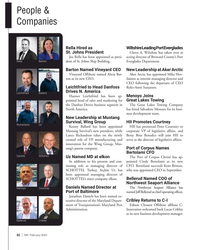 )
February 2024 - Marine News page: 42
)
February 2024 - Marine News page: 42Named Director at The Northwest Seaport Alliance has Menoyo Courtney Port of Baltimore named Jeff Bellerud as chief operating of? cer. Jonathan Daniels has been named ex- ecutive director of the Maryland Depart- Cribley Returns to C-I ment of Transportation’s Maryland Port Edison Chouest
-
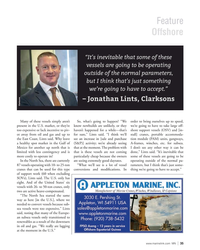 )
October 2023 - Marine News page: 35
)
October 2023 - Marine News page: 35some of these vessels are going to be operating outside of the normal parameters, but I think that’s just something we’re going to have to accept.” – Jonathan Lints, Clarksons Clarksons Many of these vessels simply aren’t So, what’s going to happen? “We order to bring ourselves up to speed, present in
-
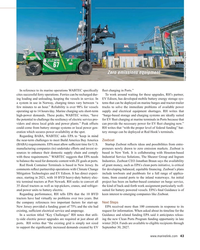 )
September 2023 - Maritime Reporter and Engineering News page: 43
)
September 2023 - Maritime Reporter and Engineering News page: 43Industrial Service Solutions, The Shearer Group and Ingram to balance the need for domestic content with ZE goals at ports. Industries. Zeeboat CEO Jonathan Braun says the availability Red Hook Container Terminals is based in New Jersey. Its of grant money, such as EPA’s clean ports initiative, is critical
-
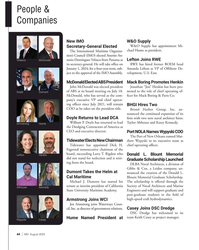 )
August 2023 - Marine News page: 44
)
August 2023 - Marine News page: 44to the approval of the IMO Assembly. velopment, U.S. East. McDonald Elected ABS President Mack Boring Promotes Henkin John McDonald was elected president Jonathan “Jon” Henkin has been pro- of ABS at its board meeting on July 18. moted to the role of chief operating of- Doyle Dumont McDonald, who has served
-
 )
January 2023 - Maritime Reporter and Engineering News page: 12
)
January 2023 - Maritime Reporter and Engineering News page: 12to be a tem and is commercially available. For the ships that already Hybrid AM system. have the Haas CNC system, it’s possible to add the Meltio Jonathan Hopkins, who leads the additive manufacturing system and Phillips integration to existing the CNS tooling to team at NSWC Carderock Division, said
-
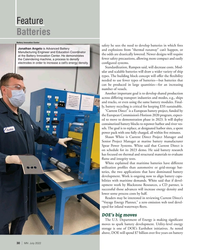 )
July 2022 - Marine News page: 29
)
July 2022 - Marine News page: 29Feature Batteries Battery Innovation Center safety he sees the need to develop batteries in which ? res Jonathan Angelo is Advanced Battery and explosions from “thermal runaway” can’t happen, or Manufacturing Engineer and Education Coordinator the odds are drastically lowered. Newer designs will
-
 )
September 2021 - Marine News page: 42
)
September 2021 - Marine News page: 42left by R. Mercury EMEA; Brad Zoelle has Keith Michel, who retired on June 30, been promoted to General Manager, Steady Grönborg APAC Region; and Jonathan Levine after nine years of service. was named General Manager, Mercury Canada. Marty Bass will be moving Savage Rejoins BMT BMT has hired Catriona
-
 )
April 2021 - Maritime Reporter and Engineering News page: 56
)
April 2021 - Maritime Reporter and Engineering News page: 56Joins Gulf Copper Board zation of group portfolio to intensify Gulf Copper and Manufacturing Cor- the growth of maritime services and poration appointed Jonathan Whit- renewable energy and decarbonization. worth as a member to its Board of “Our strategy is very clear, we will Directors. Whitworth holds an
-
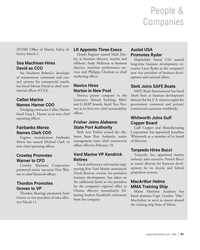 )
April 2021 - Marine News page: 41
)
April 2021 - Marine News page: 41Alabama Copper Board Gulf Copper and Manufacturing Fairbanks Morse State Port Authority Beth Ann Frisher joined the Ala- Corporation has appointed Jonathan Names Clark COO Engines manufacturer Fairbanks bama State Port Authority senior Whitworth as a member of its board Morse has named Michael Clark
-
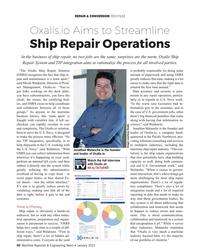 )
January 2021 - Maritime Reporter and Engineering News page: 40
)
January 2021 - Maritime Reporter and Engineering News page: 40left un- along with having that information in- checked, can rapidly escalate in cost correct,” said Waldstein. and complexity. The Oxalis.io solution, Jonathan Malanche is the founder and born to serve the U.S. Navy, is designed leader of Oxalis.io, a company head- to make the process more ef? cient. “So
-
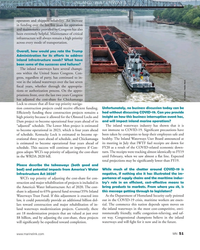 )
September 2020 - Marine News page: 51
)
September 2020 - Marine News page: 51appropria- tions or authorization process. On the appro- priations front, over the last two years Congress has adjusted the cost-share for Chickamauga © Jonathan / Adobe Stock Lock to ensure that all four top priority naviga- tion construction projects could receive ef? cient funding. Unfortunately, no business
-
 )
June 2020 - Marine News page: 57
)
June 2020 - Marine News page: 57transferred Towage operator Svitzer appointed Daniels to Lead Port Everglades command of Sector Upper Mississippi Kasper Friis Nilaus, VP and current Jonathan Daniels will be the new Chief to Capt. Richard M. Scott. Managing Director (MD) of Svitzer Executive & Port Director at Port Ever- Capt. John Reed
-
 )
April 2020 - Maritime Reporter and Engineering News page: 54
)
April 2020 - Maritime Reporter and Engineering News page: 54in their present roles on the 2020. At the same time, current Finance team, joined by Hirofumi Takano and Taira Director for Hempel Middle East Jonathan Narisawa as Executive Vice President. Mercer will take over Pernille Lind Olsen’s Koichi Fujiwara has been appointed as position as Group Vice
-
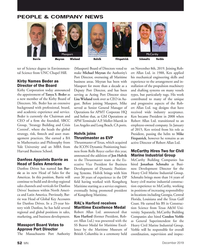 )
December 2019 - Marine News page: 52
)
December 2019 - Marine News page: 52Barrie as to the Thrustmaster team as the Ex- McCarthy Building Companies has Head of Sales Americas ecutive Vice President for Business hired Jonathan Schmaltz as Busi- Danfoss Drives has named Ian Bar- Development of Dynamic Position- ness Development Director for the rie as its new Head of Sales
-
 )
July 2019 - Marine Technology Reporter page: 73
)
July 2019 - Marine Technology Reporter page: 73QPS Inc. Zeist, The Netherlands MDs: Jonathan Beaudoin & Almar Hollaar No. of Employees: 70 https://qps.nl/ For more than 25 years, Quality Positioning Services oil and gas, offshore wind farms, and the dredging industry. (QPS) have been experts in maritime geomatics software Services include on-site
-
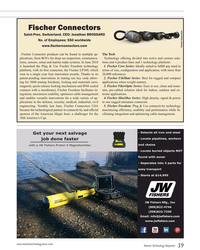 )
July 2019 - Marine Technology Reporter page: 39
)
July 2019 - Marine Technology Reporter page: 39Fischer Connectors Saint-Prex, Switzerland, CEO: Jonathan BROSSARD No. of Employees: 550 worldwide www.? scherconnectors.com Fischer Connectors Fischer Connector products can be found in multiple ap- The Tech plications, from ROVs for deep sea inspection, communica- Technology offering divided into
-
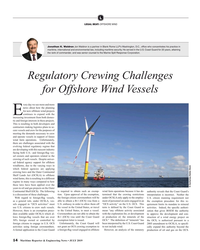 )
July 2019 - Maritime Reporter and Engineering News page: 14
)
July 2019 - Maritime Reporter and Engineering News page: 14L LEGAL BEAT: OFFSHORE WIND Jonathan K. Waldron Jon Waldron is a partner in Blank Rome LLP’s Washington, D.C., of? ce who concentrates his practice in maritime, international and environmental law, including maritime security. He served in the U.S. Coast Guard for 20 years, attaining the rank of commander
-
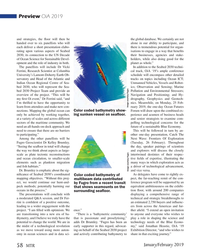 )
January 2019 - Marine Technology Reporter page: 58
)
January 2019 - Marine Technology Reporter page: 58. “Fugro has been an technology needs of the Blue Econo- the midst of a technological revolution early supporter in this regard, advocat- my,” said Jonathan Heastie, OiA ‘19 as we move toward using more auton- ing on behalf of the Seabed 2030 project Exhibition Director, “and who wishes to omy in ocean
-
 )
November 2018 - Marine Technology Reporter page: 16
)
November 2018 - Marine Technology Reporter page: 16Jonathan Heastie, Reed Exhibitions oices rine pollution and environmental stressors and the tools and give to OI visitors to come out to the San Diego event? techniques needed to address and mitigate these challenges; In simple terms, we’re delivering the world’s ? agship event plus, at the time of
-
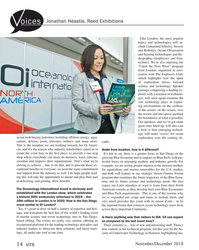 )
November 2018 - Marine Technology Reporter page: 14
)
November 2018 - Marine Technology Reporter page: 14Jonathan Heastie, Reed Exhibitions oices Like London, the most popular topics and technologies will in- clude Unmanned Vehicles, Vessels and Robotics, Ocean Observation and Sensing technologies and Hy- drography, Geophysics and Geo- technics. We’re also reprising our “Catch the Next Wave” program from
-
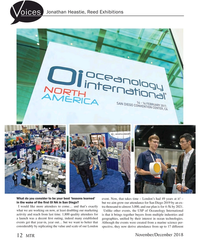 )
November 2018 - Marine Technology Reporter page: 12
)
November 2018 - Marine Technology Reporter page: 12Jonathan Heastie, Reed Exhibitions oices What do you consider to be your best ‘lessons learned’ event. Now, that takes time – London’s had 49 years at it! – in the wake of the ? rst OI NA in San Diego? but we aim grow our attendance for San Diego 2019 by an ex- I would like more attendees to come… and
-
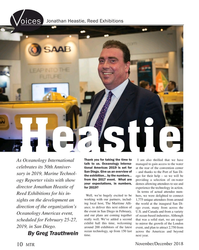 )
November 2018 - Marine Technology Reporter page: 10
)
November 2018 - Marine Technology Reporter page: 10Jonathan Heastie, Reed Exhibitions oices Heastie Thank you for taking the time to I am also thrilled that we have As Oceanology International talk to us. Oceanology Interna- managed to gain access to the water celebrates its 50th Anniver- tional Americas 2019 is set for at the rear of the convention
-
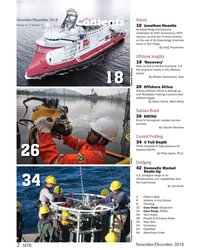 )
November 2018 - Marine Technology Reporter page: 2
)
November 2018 - Marine Technology Reporter page: 2November/December 2018 Voices Contents Volume 61 • Number 9 10 Jonathan Heastie As Oceanology International celebrates its 50th anniversary, MTR catches up with the Oi show director on the eve of its Oceanology Americas event in San Diego. By Greg Trauthwein Offshore Insights 18 ‘Recovery’ Cost
-
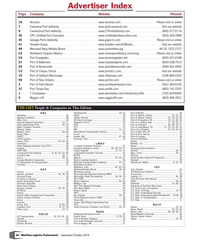 )
Sep/Oct 2018 - Maritime Logistics Professional page: 64
)
Sep/Oct 2018 - Maritime Logistics Professional page: 64....... 31 Minsheng Leasing ................................................ 31 The Mission to Seafarers ..................................... 51 Daniels, Jonathan .................................... 36, 38, 39 Mississippi Development Authority (MDA) ............... 34 Transocean ........................
